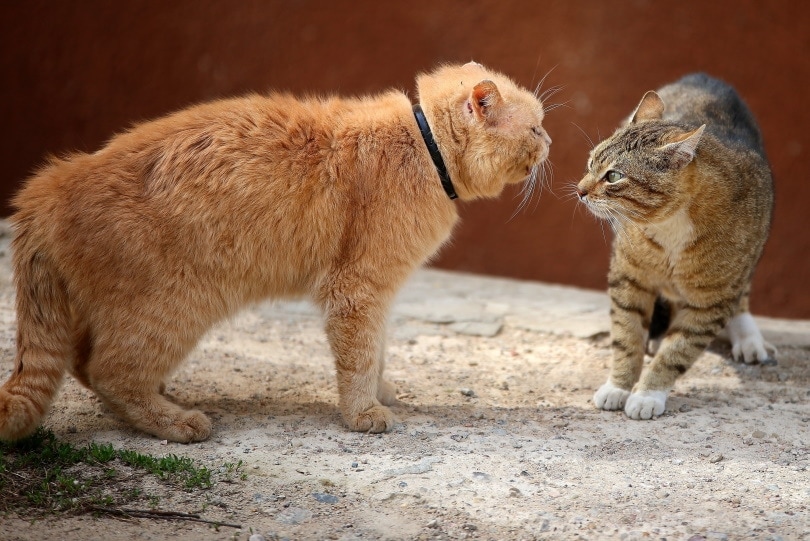
Getting a new feline is often exciting. However, if you already have a cat, this period can also be quite stressful. Most cats are not welcoming toward a new feline in their home. After all, your cat sees their home as their territory, which makes the new cat a trespasser.
Therefore, it’s essential to get the introduction process right. Otherwise, fights can break out. Without intervention, cats often stay enemies and can continue to fight for years.
The 8 Do’s of Introducing Two Cats
1. Do separate the cats at first.
Your cats should be kept in completely separate areas at first. You should allow the new cat to get used to their litter area. Having a place where the new cat is confident is often key to a proper introduction. Leave the cats separated until you’re sure they can behave together.
2. Do slowly introduce them.
Slowly introduce the cats to each other. At first, you can try feeding them on opposite sides of the same door. Then, slowly allow the cats to see each other. You can do this by simply cracking the door or setting up a screen door. The initial method doesn’t matter; just be sure that the cats can’t physically access each other.

3. Do use “scent soakers.”
Cats rely on their sense of smell to get information about the world. Therefore, you can use this to your advantage when introducing cats to each other. Provide blankets for your cats to lie on and put towels under their food bowls. Once the cats have used the items for a few days, switch them. Each cat will then get to smell the other, but at a safe distance.
4. Do keep physical introductions short.
Once your cats are fine with each other with the barrier in place, you can put them in the same room. Preferably, you would do this by leaving the door cracked and allowing the cats to enter the other’s space on their own accord — with your supervision, of course. However, you should keep these sessions extremely short. You want them to end on a happy note.
5. Do have sight blockers ready.
You should have sight blockers prepared for physical introductions. These can help prevent fights if things start going south. They can also help stop fights once they break out if one of the felines happens to get away. Basically, these sight blockers are simply something that the cat can’t see or get through, like a larger piece of cardboard. If things go south, place it between your cats.
6. Do block off “unders.”
When cats start to fight, one will often attempt to run away. Typically, the cat will try to hide under something, like a couch. Of course, the other cat can go under the couch too, which leads to the fight happening someplace that you can’t access. Therefore, you should block off any small areas that your cats may try to hide in. You want the fight to happen in the open where you can intervene.

7. Do keep a blanket on hand.
You should always have a blanket on hand just in case the previous methods don’t work. If a fight breaks out, a blanket can be your best tool. You can simply toss it over one of the cats, pick them up, and remove them from the room. Otherwise, you may end up with injuries yourself.
8. Do use distraction.
The easiest way to keep your cats from fighting when introducing them physically is to use a distraction. A partner is often helpful for this step so one person can distract each cat. Use plenty of affection and treats to keep each cat’s attention. You don’t want them paying much attention to the other cat at first. You just want them to be in proximity to each other.
The 4 Don’ts of Introducing Two Cats
1. Don’t put them together right away.
The biggest mistake that pet parents make is simply putting the new and old cats together in the same room and hoping for the best. While some cats can get along fine with this method, many will end up fighting and taking a long time to be happy together. Therefore, it’s important to introduce them slowly and purposefully.
2. Don’t force interaction.
You should never try to force your cats to interact. When cats are friendly, they often ignore each other. Interaction can sometimes be seen as aggression, even if it’s you shoving the kitten in the old cat’s face. You should always allow cats to interact on their own terms, and don’t be surprised if that involves ignoring each other.

3. Don’t start introductions right away.
You should provide the new cat with a few days to get comfortable in their new home before starting any introductions. The new feline already has enough on their plate; they don’t need to deal with your other cat on top of everything else. Wait until the new cat is comfortable in their environment.
4. Don’t rush things.
Introducing cats takes quite a while, so don’t rush things. You should expect it to take a few weeks at least. In some cases, cats may even require a few months before they can be left alone unsupervised. It depends on the cats’ temperaments.
Final Thoughts
When introducing cats to each other, it is essential to take things slow and steady. At the time, it may seem like you aren’t getting anywhere. However, after a while, you’ll end up with cats that don’t fight and can stand to be around each other.
Having two cats that fight can be extremely stressful for the whole household. Re-introducing cats is often nearly impossible, as cats will remember disliking the other one. Also, stopping the fighting habit can be hard once it starts.
Therefore, you should go as slow as you need to to ensure that your felines are introduced properly and safely.
Featured Image Credit: Nils Jacobi, Shutterstock






